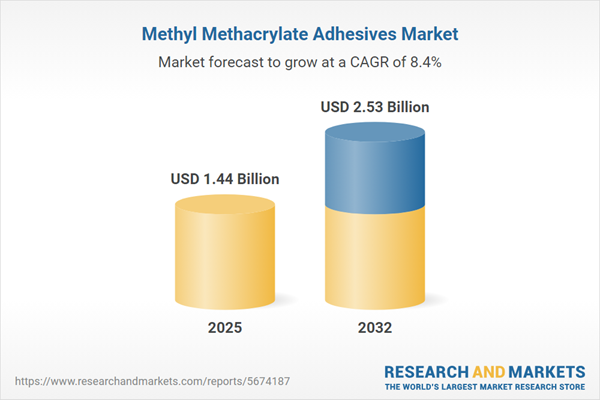Speak directly to the analyst to clarify any post sales queries you may have.
Senior leaders in the methyl methacrylate adhesives market are under increasing pressure to balance compliance, efficiency, and sustainability while ensuring agility in supply chains and product strategies. This overview streamlines strategic information, enabling C-suite teams to guide innovation, sourcing decisions, and responses to changing global requirements.
Methyl Methacrylate Adhesives Market Snapshot
The methyl methacrylate adhesives market reached USD 1.33 billion in 2024 and is projected to expand to USD 1.44 billion by 2025, maintaining a compound annual growth rate of 8.36%. By 2032, forecasts estimate the market will widen to USD 2.53 billion. Sectors including automotive, aerospace, medical devices, and general industry are driving this momentum as they demand reliable, high-performance adhesive solutions and adapt to evolving regulatory environments. Strategies are centering on greater transparency and minimizing environmental impact, while operational efficiency and robust supplier relationships become essential to strengthen compliance and sustainability positions in the sector.
Methyl Methacrylate Adhesives Market: Scope & Segmentation
- Application Areas: Automotive, construction, consumer goods, electronics, medical, machinery, and assembly each require adhesive solutions with tailored durability, safety, and alignment to specific regulatory requirements.
- Formulation Types: One-component adhesives are optimized for assembly line efficiency, while two-component systems are engineered for enhanced strength in demanding operational environments.
- Product Forms: Options span coated films, preformed sheets, solvent-based and water-based liquids, plus versatile single and dual-component pastes to adapt across diverse production workflows.
- Cure Mechanisms: Heat-activated, anaerobic, free-radical, moisture-cured, and ultraviolet systems support compliance with quality standards and compatibility across a range of substrates.
- Distribution Channels: Direct sales to original equipment manufacturers, comprehensive wholesaler and retailer networks, and specialized ecommerce platforms facilitate market reach and delivery efficiency.
- Regional Coverage: North America, Europe, Middle East & Africa, and Asia-Pacific each demand region-specific product strategies that consider regulatory nuances and unique supply chain dynamics.
- Company Profiles: Leading organizations such as Dow Inc., 3M Company, Arkema S.A., Evonik Industries AG, Sika AG, H.B. Fuller Company, Henkel AG & Co. KGaA, Illinois Tool Works Inc., RPM International Inc., and Ashland Global Holdings Inc. set standards for investment, innovation, and reliable supply partnership.
Methyl Methacrylate Adhesives Market: Key Takeaways
- Material science advancements are allowing manufacturers in sectors like transportation and healthcare to elevate product consistency and meet stringent quality targets.
- Adoption of bio-based and low-VOC adhesives is increasing as companies address new environmental regulations and advance their sustainability initiatives throughout the value chain.
- Hybrid curing technologies, including ultraviolet and moisture-cure processes, enable businesses to navigate operational constraints and regional compliance challenges.
- Collaboration between suppliers and OEMs is accelerating new product development, shortening time-to-market, and supporting agile responses to changing policies.
- Strategic regional adaptation of raw materials and processing methods is improving supply network resilience and bolstering responsiveness to logistics or legislative changes.
United States Tariffs: Impact on Supply Chain and Cost Management
Recent tariff changes in the United States for methyl methacrylate adhesives have led to higher raw material costs and restricted supplier choices. Procurement leaders are encouraged to broaden supplier bases and strengthen logistics frameworks for cost management. Utilizing predictive analytics alongside dynamic procurement tools supports agile adjustments to market shifts. Executives can leverage dynamic pricing strategies to protect margins and inform planning as legislative changes unfold.
Methodology & Data Sources
This analysis draws from executive interviews, peer-reviewed publications, and validated data from reputable secondary sources. Each finding is tested for operational relevance, helping guide procurement, compliance, and management initiatives.
Why This Report Matters
- Presents a structured, actionable assessment of key market segments, business value drivers, and macro trends to empower strategic risk and investment planning.
- Supports executive teams in pinpointing supply chain risks, accelerating technology adoption, and adapting flexibly to shifting regulatory requirements.
- Provides reliable data and insights to inform critical decisions in opportunity evaluation, technology upgrades, or compliance risk mitigation within the adhesives sector.
Conclusion
Market clarity and practical insights from this report guide leaders in strengthening compliance, innovating product lines, and reinforcing resilience as the methyl methacrylate adhesives industry evolves.
Additional Product Information:
- Purchase of this report includes 1 year online access with quarterly updates.
- This report can be updated on request. Please contact our Customer Experience team using the Ask a Question widget on our website.
Table of Contents
3. Executive Summary
4. Market Overview
7. Cumulative Impact of Artificial Intelligence 2025
Companies Mentioned
The companies profiled in this Methyl Methacrylate Adhesives market report include:- Dow Inc.
- 3M Company
- Arkema S.A.
- Evonik Industries AG
- Sika AG
- H.B. Fuller Company
- Henkel AG & Co. KGaA
- Illinois Tool Works Inc.
- RPM International Inc.
- Ashland Global Holdings Inc.
Table Information
| Report Attribute | Details |
|---|---|
| No. of Pages | 180 |
| Published | November 2025 |
| Forecast Period | 2025 - 2032 |
| Estimated Market Value ( USD | $ 1.44 Billion |
| Forecasted Market Value ( USD | $ 2.53 Billion |
| Compound Annual Growth Rate | 8.3% |
| Regions Covered | Global |
| No. of Companies Mentioned | 11 |









